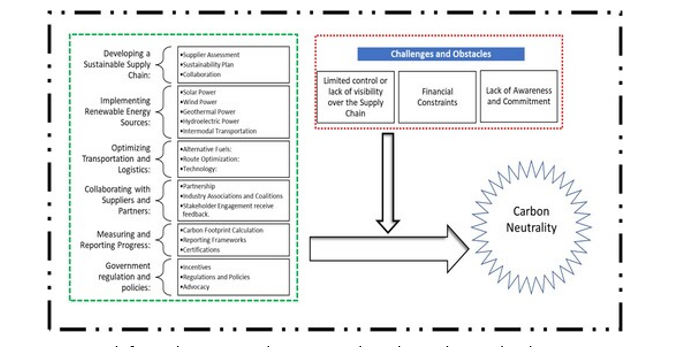What happens when R&D stops being a back-office function and becomes a strategic lever for sustainability? We're seeing that shift unfold as companies rethink how products move from concept to consumer—not just for speed or cost but also for environmental impact.
This evolution is driven by more than regulation or reputation. It reflects a more profound understanding that sustainability and long-term business performance are fundamentally connected. Today's most resilient supply chains aren't just optimized for efficiency—they're designed with environmental intelligence.
In this article, we explore how R&D is helping companies understand, reduce, and ultimately rethink their supply chain carbon footprint—starting with where emissions genuinely originate.
Understanding Supply Chain Carbon Footprint
A supply chain's carbon footprint includes all greenhouse gas emissions associated with a product or service throughout its lifecycle, from raw material sourcing to disposal. A significant difficulty lies in managing 'Scope 3' emissions—those indirect emissions occurring outside a company's direct control yet still linked to its operations. These include emissions from upstream activities like the production of raw materials and transportation and downstream activities like product use and disposal. These are difficult to quantify but crucial to address for effective carbon reduction.
With supply chains estimated to account for about 60% of global carbon emissions, achieving net-zero targets depends on improving supply chain sustainability. R&D is vital in this effort by developing answers, including tech advancements, optimized logistics, and stronger supplier partnerships. These efforts focus on creating an eco-friendlier value chain, reducing the overall carbon footprint, and contributing to global climate goals.
Evolution of Supply Chain Sustainability
Traditional supply chain management primarily emphasized cost optimization and efficiency, focusing on lean manufacturing, just-in-time inventory, and global sourcing for cost savings, with minimal consideration for environmental impact. The drive for efficiency and speed dominated decision-making, leading to supply chains that were economically optimized but ecologically compromised. However, growing awareness of the environmental effects and increasing regulatory pressures have catalyzed a fundamental change in approach.
Modern supply chain R&D now adopts a triple bottom line framework, where ecological sustainability, economic viability, and social responsibility build a sustainable supply chain strategy. Environmental sustainability includes science-based carbon reduction targets, zero-waste manufacturing processes, and biodiversity impact considerations. At the same time, economic viability has expanded beyond traditional cost metrics to encompass long-term resource security, risk mitigation through environmental preparedness, and market share growth driven by sustainability leadership. Additionally, social responsibility has become equally important, focusing on fair labor practices, community impact, and ethical sourcing standards.
This change has not happened in isolation but has been driven by a convergence of factors in the business environment:

R&D Initiatives in Sustainable Supply Chain Management
In the pursuit of net-zero goals and circular economy models, research and development (R&D) has emerged as a strategic lever across the value chain. From raw material sourcing to manufacturing and logistics, forward-thinking companies are embedding sustainability into the DNA of their innovation efforts. Below, we explore how companies like Unilever and Walmart leverage R&D to drive impactful transformations at every operational stage.
1. Raw Material Sourcing: Rethinking Inputs for a Sustainable Future
Modern R&D teams are reimagining the material foundation of product portfolios by identifying and implementing alternatives that reduce environmental impact. Key initiatives include:
- Sustainable Material Development: Focused efforts are underway to replace traditional inputs with recycled, renewable, or bio-based materials.
- Supplier Collaboration for Sustainable Sourcing: Researchers engage upstream with suppliers to source low-emission raw materials and promote responsible practices.
- Life Cycle Assessment (LCA) and Optimization: Through LCAs, R&D teams can identify the most environmentally intensive stages of material use and guide decisions that reduce impact.
Case in Point: Unilever
Unilever has invested significantly in R&D to transition toward sustainable raw materials, such as RSPO-certified palm oil. Their innovation teams are also advancing the use of recycled plastics and plant-based packaging.
Impact: This initiative reduces packaging-related emissions while aligning with broader circular economy goals.
2. Manufacturing Process: Reducing Emissions and Waste at the Core
The manufacturing phase offers significant environmental improvement opportunities through energy and material efficiency. R&D is driving:
- Energy Efficiency Optimization: Implementing high-efficiency equipment, intelligent energy systems, and renewable energy solutions reduces manufacturing operations’ carbon footprint.
- Waste Minimization and Resource Optimization: To improve material efficiency, closed-loop systems, scrap reduction techniques, and reuse strategies are being pioneered.
Case in Point: Walmart
Walmart has committed to transitioning to 100% renewable energy globally. Their R&D team spearheads solar energy deployment across distribution centers and retail locations.
Impact: These efforts are poised to cut operational emissions significantly while reducing long-term energy costs.
3. Logistics & Distribution: Smarter, Leaner, and Cleaner Operations
Distribution and logistics are traditionally carbon-intensive segments of the value chain, but R&D innovation is paving the way for more efficient practices:
- Optimized Route Planning: AI-powered systems now enable dynamic route planning based on real-time traffic, weather, and delivery windows, significantly reducing emissions.
- Packaging Innovation: Minimalist and biodegradable packaging designs help reduce weight, volume, and waste during transportation.
Case in Point: Unilever
Unilever’s R&D has implemented AI-driven logistics planning to lower emissions and improve fuel efficiency.
Impact: Optimized logistics has enabled faster deliveries with lower environmental costs.
Challenges and Opportunities in Sustainable Supply Chain R&D Initiatives
- Balancing Cost Considerations with Sustainability Goals:
- Challenge: Implementing eco-friendly methods often requires high initial costs with an unclear return on investment.
- Opportunity: R&D teams focus on answers that simultaneously deliver sustainability and efficiency improvements, such as packaging designs that reduce material usage and shipping costs.
- Supply Chain Complexity & Transparency:
- Challenge: With thousands of suppliers across multiple tiers, thorough eco-friendliness monitoring is seemingly impossible as organizations struggle to obtain reliable data beyond their tier-1 suppliers.
- Opportunity: Researchers are leading supplier engagement platforms that combine technology with capacity building, including developing blockchain-enabled traceability systems, satellite monitoring technologies, and AI-powered risk assessment tools.
- Integrating New Technologies with Existing Infrastructure:
- Challenge: Many organizations operate with outdated supply chain systems that are not designed to track sustainability metrics or optimize for ecological impact.
- Opportunity: R&D has developed middleware solutions and APIs to bridge sustainability data with legacy systems. Developed cloud-based platforms can integrate environmental intelligence into existing supply chain processes without complete system overhauls.
- Regulatory Uncertainty & Regional Variation:
- Challenge: Governments are implementing stricter regulations on emissions, prompting companies to innovate.
- Opportunity: R&D teams are creating sustainability solutions that can be rapidly reconfigured as regulations evolve, while governance structures are being reimagined to enhance adaptability to changing requirements.
- Consumer Expectations & Market Dynamics:
- Challenge: Rapidly changing consumer preferences regarding sustainability and willingness to pay premiums for sustainable products vary significantly across markets and demographics.
- Opportunity: R&D teams are developing adaptable, sustainable product platforms that cater to various market segments while achieving economies of scale. They also utilize sophisticated data analysis to help companies identify the sustainability attributes influencing purchasing decisions in different contexts.
Conclusion: R&D Paving the Way to Tomorrow's Sustainable Supply Chains
Today's supply chains are undergoing a profound change, evolving from cost-focused operations to strategic drivers of sustainability. Sustainability is now central to supply chain strategy, enabling companies to mitigate environmental risks while creating fresh value offerings.
R&D is leading this change, turning sustainability challenges into creative opportunities. This includes developing circular systems that convert waste into resources, implementing digital technologies to enhance ecological performance, and designing resilient networks to withstand climate disruptions.
R&D is taking a holistic approach to sustainability by conducting comprehensive life cycle assessments to identify key areas for innovation. By viewing sustainability challenges as opportunities for creative problem-solving, R&D teams are discovering solutions that deliver value across multiple dimensions.
Evalueserve's IP and R&D expertise can help CPG companies maximize the potential of LCA by providing valuable market insights, optimizing product and process designs for sustainable supply chain management, and aligning patent strategies with ecological goals. Through these initiatives, companies can drive innovation, reduce their environmental impact, and position themselves for long-term success in a sustainability-focused world.
Talk to One of Our Experts
Get in touch today to find out about how Evalueserve can help you improve your processes, making you better, faster and more efficient.



